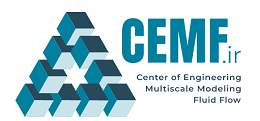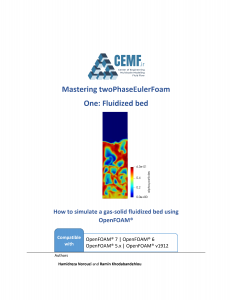In this tutorial you will learn how to simulate a gas-solid fluidized bed using OpenFOAM® (twoPhaseEulerFoam). The tutorial also contains a complete description of physical models and available options through which you can customize your simulation. In addition, you can see the animation of this simulation here. The video is also uploaded on YouTube.
- Solver: twoPhaseEulerFoam
- Compatible with: OpenFOAM 7, OpenFOAM 6, OpenFOAM 5.x, OpenFOAM v1912
- Model: Euler-Euler compressible flow, RAS turbulence model, 3D
- Physical system: A gas solid fluidized bed in bubbling regime.
- Video: See the animation of this simulation here.
- Description: The gas-solid fluidized bed is a flat bed with rectangular cross section with dimensions 150x28x2.5 cm3 . This bed is filled up to 40 cm with 275-microns spherical glass beads with the density of 2500 kg/m3 . The packing fraction (solid volume fraction) is assumed to be 0.6 and the maximum packing fraction was assumed to be 0.63. These particles are fluidized with air at ambient conditions (here we assume 1 atm and 283 K). This condition exactly corresponds to the experiments performed by Taghipour et al. [Taghipour, Ellis, & Wong, 2005. Chemical Engineering Science, 60, 6857–6867].




Hello! Thanks for your tutorial. Can I use twoPhaseEulerFoam for simulating a rotating drum (or disk in 2D) containg granular material and air as the second phase?
Thanks. Yes. You can use MRF to simulate the rotating region of the fluidized bed.
Hello, how can I use your tutorial to simulate water jet impinging unto free water surface. Thanks
Hi, please give me more info so I can help you.
Hi…
Could you present a 3D example on this topic (fuel bed). I am dealing with a fluidized bed furnace in the shape of a two-roller pipe, at half its height it changes from a cylinder with a smaller diameter to a cylinder with a larger diameter. It would help me a lot in adapting to my needs. Regards
Mirosław
Hi,
I just replied you. You may want to consider the radiative heat transfer at high temperatures if you are investigating the heat effects in your work.
Is there a 3d example for this type of simulation? Regards M.Fatyga
The 3D simulation is essentially the same. You only need to create a 3D mesh for it and change the numerical schemes a little bit to correct for non-orthogonality of mesh (if the 3D mesh is non-orthogonal).
Thanks a lot. I’m trying to take your advice.
Kind regards
h.norouzi…
Thank you for the good advice – I have made a 3D model of the fluidized bed furnace and I am simulating the process parameters as in my company.
Kind regards
M. Fatyga